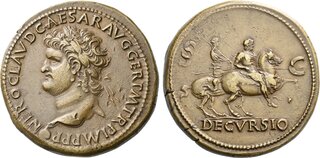| Numismatica Ars Classica > Auction 144 with CNG & NGSA | Auction date: 8 May 2024 |
| Lot number: 1035 Price realized: This lot is for sale in an upcoming auction - Bid on this lot  | Show similar lots on CoinArchives Find similar lots in upcoming auctions on |
| Lot description: The Geoffrey Cope Collection of Ancient Greek and Roman Bronzes. The Roman Empire. Nero augustus, 54 – 68. Description Sestertius, Lugdunum circa 65, Æ 37 mm, 29.69 g. NERO CLAVD CAESAR AVG GER PM TR P IMP P P Laureate head l.; with globe at point of bust. Rev. DECVRSIO Nero on horseback r., holding spear; behind him, mounted soldier prancing r., with vexillum over r. shoulder. In field, S - C. Reference C 84 BMC 312 var. (laureate r.) RIC 437 CBN 82 Condition A spectacular and very realistic portrait of Nero struck on an exceptionally large and with a very finely detailed reverse die. A wonderful untouched brown tone, unobtrusive die shift on reverse, otherwise good extremely fine Provenance Leu sale 25, 1980, 253 Note: The reverse of this sestertius features Nero charging on horseback with a couched cavalry spear riding alongside a horseman carrying a vexillum. While the military character of the scene is obvious, the succinct legend DECVRSIO identifies the specific event. This is not a representation of the emperor charging into the thick of battle with the enemy, but rather of a military exercise practised by the Roman army since the days of the Republic. Originally, the decursio was a periodic exercise used to train soldiers for long marches and often ended with a mock battle between divisions. Although such exercises were held on a much more frequent basis under the Empire, by this time they also took on an honorific character. Special decursiones were held as a mark of military honour at the funerals of successful generals and of emperors. These usually involved the marching of the army three times around the funeral pyre of the deceased honorand followed by a mock battle. Despite the established Roman tradition of the decursio, Nero's DECVRSIO sestertii, which were struck at Rome and Lugdunum between 63 and 67, have often been associated with the populist and theatrical character of his reign. Some commentators have tried to link them to the emperor's institution of the Neronian Games or with a performance of the Trojan Games at the funeral of his daughter Claudia in 63, although neither of these actually fit the definition of a decursio. Somewhat more plausible is the explanation that the DECVRSIO types represent a real or invented military exercise involving the Praetorian Guard as a means of propagandising Nero's good relationship with them. Perhaps coins such as this were even distributed as donatives on occasions of actual exercises undertaken by the Praetorians as a means of expressing imperial gratitude for their continued loyalty. After all, as history shows, it could be very unhealthy for emperors to get on the bad side of the Praetorian Guard. Estimate: 15000 CHF |  |



